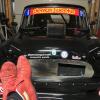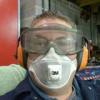Still Too Lean!
#1

Posted 20 May 2019 - 10:00 PM
The jet adjusters are virtually at the end of their threads and it still hunts on idle and the LCB manifold runs hot. I would welcome any suggestions including whether there is a suitable richer needle I could use?
#2

Posted 20 May 2019 - 10:04 PM
as per Vizzard AF or E8
#3

Posted 21 May 2019 - 08:09 AM
OK thanks, don't know why I didn't check the bible first - do you know roughly how many flats of the jet adjusters each needle equates to?as per Vizzard AF or E8
#4

Posted 21 May 2019 - 11:40 AM
Do not adjust the running fueling by turning the mixture screws. These screws set the idle fueling only. The needle selection changes the running fueling. Adjusting the idle mix by turning the mixture nuts rich to try an compensate for flat spots and hesitation is the fastest way to ruin a perfectly good engine.
Ac
#5

Posted 21 May 2019 - 05:05 PM
Edited by johnR, 21 May 2019 - 05:12 PM.
#6

Posted 21 May 2019 - 06:22 PM
There is something very wrong if the jet screws have to be wound all the way out.
That usually indicates a large air leak.
Ac
#7

Posted 21 May 2019 - 06:54 PM
#8

Posted 21 May 2019 - 07:00 PM
+1 for an air leak somwhere in the intake system. Either that or fuel is not getting to the jet.
I'm running a 1293 with MD266 and twin HS2s. The sequence of needles I would suggest is: leanest - AH2 - QA - AO - richest. These needles all use the same first three diameters of 890 - 850 - 820 (these are the diameters which affect idle mixture)
The E2 is well different, never come across that profile before. The first three diameters of the E2 are 880 - 845 - 810 which in a typical twin HS2 fast road setup would probably require the jet heights to be set flush with the bridge and even then the E2 is most likely to give sooty plugs.
I've had idle problems before with twin HS2s, and all have been due to air leaks. Here is a selection of the issues I have experienced:
- inlet manifold face thickness less than exhaust, poor clamping. Needed high idle to keep running.
- locating rings holding inlet manifold slightly proud, poor sealing. Needed high idle to keep running.
- fabricated inlet manifold faces not sitting flat on gasket. Needed high idle to keep running.
But now all running smoothly, just took a bit of time to get sorted...
Edited by carbon, 21 May 2019 - 07:02 PM.
#9

Posted 21 May 2019 - 07:10 PM
Fuel not getting to jet... About 5 years back I was having real bother with the 1330 which uses a single HS4 - running real weak and getting steadily worse but still had steady idle. Was experiencing fuel starvation at anything over 30mph. Did all the usual checks on fuel flow, pressure, tank breather etc. Nothing out of order.
Turned out it was the rubber seal at base of the float chamber, where the plastic nylon tube goes in to the base of the float chamber. Fuel had swollen this over time to the point where there must have been just a tiny hole letting the fuel through.
A new seal (AUD 2194) and it was transformed back to normal running.
#10

Posted 21 May 2019 - 07:16 PM
Yes, that's what we thought, but have been all round the carbs and manifolds with WD40 and cant find one. Also I've changed gaskets for a better seal, smeared hylomar round inlet holes on gasket, matched inlet and exhaust flanges, blocked servo vacuum port. Unless air is passing through the block or head walls I don't know where it's coming from! Good compression by the way. it's going in for it's MOT tomorrow so will then know what the analysis is.
John,
When you say air passing through the block, do you mean getting into the inlet manifold via the closed circuit engine breather? These can also give rise to a whole load of grief. Twin HS2s used two versions as standard:
- PCV valve direct into the inlet manifold
- 'Y' piece connected upstream of the butterflies
Do you have either of these fitted?
#11

Posted 21 May 2019 - 07:19 PM
As you will see from my previous post I matched the exhaust and inlet manifold flange thicknesses, there are no locating rings on my inlet manifold - pins in head locate it to matched holes in flanges and spraying WD40 round these points (and carb spindles) showed up no leaks.+1 for an air leak somwhere in the intake system. Either that or fuel is not getting to the jet.
I'm running a 1293 with MD266 and twin HS2s. The sequence of needles I would suggest is: leanest - AH2 - QA - AO - richest. These needles all use the same first three diameters of 890 - 850 - 820 (these are the diameters which affect idle mixture)
The E2 is well different, never come across that profile before. The first three diameters of the E2 are 880 - 845 - 810 which in a typical twin HS2 fast road setup would probably require the jet heights to be set flush with the bridge and even then the E2 is most likely to give sooty plugs.
I've had idle problems before with twin HS2s, and all have been due to air leaks. Here is a selection of the issues I have experienced:
- inlet manifold face thickness less than exhaust, poor clamping. Needed high idle to keep running.
- locating rings holding inlet manifold slightly proud, poor sealing. Needed high idle to keep running.
- fabricated inlet manifold faces not sitting flat on gasket. Needed high idle to keep running.
But now all running smoothly, just took a bit of time to get sorted...
#12

Posted 21 May 2019 - 07:25 PM
I have breathers connected to the carbs as in this picture - the brass 't' feeds into a 'Y' piece to the low pressure side of the carbsJohn,Yes, that's what we thought, but have been all round the carbs and manifolds with WD40 and cant find one. Also I've changed gaskets for a better seal, smeared hylomar round inlet holes on gasket, matched inlet and exhaust flanges, blocked servo vacuum port. Unless air is passing through the block or head walls I don't know where it's coming from! Good compression by the way. it's going in for it's MOT tomorrow so will then know what the analysis is.
When you say air passing through the block, do you mean getting into the inlet manifold via the closed circuit engine breather? These can also give rise to a whole load of grief. Twin HS2s used two versions as standard:
- PCV valve direct into the inlet manifold
- 'Y' piece connected upstream of the butterflies
Do you have either of these fitted?

#13

Posted 21 May 2019 - 07:30 PM
The rubber seals in my float bowls are placed over the brass ends of jet pipes before insertion in the base of the float bowls so cant block the jets - their compression by screwing the nuts in seals the pipes to the bowls.Fuel not getting to jet... About 5 years back I was having real bother with the 1330 which uses a single HS4 - running real weak and getting steadily worse but still had steady idle. Was experiencing fuel starvation at anything over 30mph. Did all the usual checks on fuel flow, pressure, tank breather etc. Nothing out of order.
Turned out it was the rubber seal at base of the float chamber, where the plastic nylon tube goes in to the base of the float chamber. Fuel had swollen this over time to the point where there must have been just a tiny hole letting the fuel through.
A new seal (AUD 2194) and it was transformed back to normal running.
#14

Posted 21 May 2019 - 07:32 PM
John, your breather set-up is a lot more forgiving than the PCV. But try disconnecting, and plug off where it goes into the carbs.
If this does not help do you know what diameter the inlet ports were taken out to when head was modified? (Just in case it has broken into one of the pushrod holes)
Then back onto the fuel delivery side.
#15

Posted 21 May 2019 - 07:35 PM
The rubber seals in my float bowls are placed over the brass ends of jet pipes before insertion in the base of the float bowls so cant block the jets - their compression by screwing the nuts in seals the pipes to the bowls.Fuel not getting to jet... About 5 years back I was having real bother with the 1330 which uses a single HS4 - running real weak and getting steadily worse but still had steady idle. Was experiencing fuel starvation at anything over 30mph. Did all the usual checks on fuel flow, pressure, tank breather etc. Nothing out of order.
Turned out it was the rubber seal at base of the float chamber, where the plastic nylon tube goes in to the base of the float chamber. Fuel had swollen this over time to the point where there must have been just a tiny hole letting the fuel through.
A new seal (AUD 2194) and it was transformed back to normal running.
So was mine...the rubber seal was placed over the jet pipe before insertion in the base of the float bowl. The rubber expanded and must have softened enough to allow it to flow. Took about 25 years.
0 user(s) are reading this topic
0 members, 0 guests, 0 anonymous users















